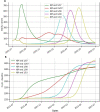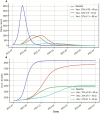Non-pharmaceutical interventions and COVID-19 vaccination strategies in Senegal: a modelling study
- PMID: 35193893
- PMCID: PMC8882665
- DOI: 10.1136/bmjgh-2021-007236
Non-pharmaceutical interventions and COVID-19 vaccination strategies in Senegal: a modelling study
Abstract
Background: When vaccines against the novel COVID-19 were available in Senegal, many questions were raised. How long should non-pharmaceutical interventions (NPIs) be maintained during vaccination roll-out? What are the best vaccination strategies?
Methods: In this study, we used an age-structured dynamic mathematical model. This model uses parameters based on SARS-CoV-2 virus, information on different types of NPIs, epidemiological and demographic data, some parameters relating to hospitalisations and vaccination in Senegal.
Results: In all scenarios explored, the model predicts a larger third epidemic wave of COVID-19 in terms of new cases and deaths than the previous waves. In a context of limited vaccine supply, vaccination alone will not be sufficient to control the epidemic, and the continuation of NPIs is necessary to flatten the epidemic curve. Assuming 20% of the population have been vaccinated, the optimal period to relax NPIs would be a few days from the last peak. Regarding the prioritisation of age groups to be vaccinated, the model shows that it is better to vaccinate individuals aged 5-60 years and not just the elderly (over 60 years) and those in high-risk groups. This strategy could be more cost-effective for the government, as it would reduce the high costs associated with hospitalisation. In terms of vaccine distribution, the optimal strategy would be to allocate full dose to the elderly. If vaccine doses are limited, half dose followed by full dose would be sufficient for people under 40 years because whether they receive half or full dose, the reduction in hospitalisations would be similar and their death-to-case ratio is very low.
Conclusions: This study could be presented as a decision support tool to help devise strategies to control the COVID-19 pandemic and help the Ministry of Health to better manage and allocate the available vaccine doses.
Keywords: COVID-19; control strategies; mathematical modelling; prevention strategies; vaccines.
© Author(s) (or their employer(s)) 2022. Re-use permitted under CC BY-NC. No commercial re-use. See rights and permissions. Published by BMJ.
Conflict of interest statement
Competing interests: None declared.
Figures





References
-
- World Health Organization . Coronavirus disease (COVID-19) Dashboard. Available: https://covid19.who.int [Accessed 22 Jan 2021].
-
- Coronavirus : la Côte d’Ivoire prend des mesures sanitaires l’aéroport d’Abidjan, 2020. Available: https://www.france24.com/fr/20200201-coronavirus-la-c%C3%B4te-d-ivoire-p... [Accessed 18 Dec 2021].
-
- Le Nestour A, Mbaye S, Moscoviz L. Enquête téléphonique sur La crise Du Covid Au Sénégal. Center for Global Development, 2020: 25.
Publication types
MeSH terms
Substances
LinkOut - more resources
Full Text Sources
Medical
Miscellaneous
